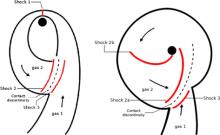
Abstract
A tidal disruption event (TDE) takes place when a star passes near enough to a massive black hole to be disrupted. About half the star's matter is given elliptical trajectories with large apocenter distances, and the other half is unbound. To form an accretion flow, the bound matter must lose a significant amount of energy, with the actual amount depending on the characteristic scale of the flow measured in units of the black hole's gravitational radius ( erg). Recent numerical simulations have revealed that the accretion flow scale is close to the scale of the most bound initial orbits,
erg). Recent numerical simulations have revealed that the accretion flow scale is close to the scale of the most bound initial orbits,  cm from the black hole, and the corresponding energy dissipation rate is
cm from the black hole, and the corresponding energy dissipation rate is  erg s−1. We suggest that the energy liberated during the formation of the accretion disk, rather than the energy liberated by subsequent accretion onto the black hole, powers the observed optical TDE candidates. The observed rise times, luminosities, temperatures, emission radii, and line widths seen in these TDEs are all more readily explained in terms of heating associated with disk formation rather than in terms of accretion.
erg s−1. We suggest that the energy liberated during the formation of the accretion disk, rather than the energy liberated by subsequent accretion onto the black hole, powers the observed optical TDE candidates. The observed rise times, luminosities, temperatures, emission radii, and line widths seen in these TDEs are all more readily explained in terms of heating associated with disk formation rather than in terms of accretion.